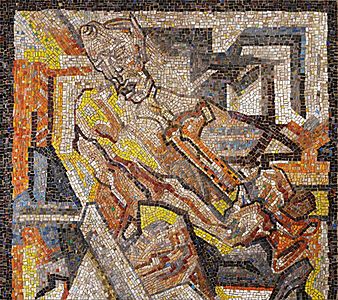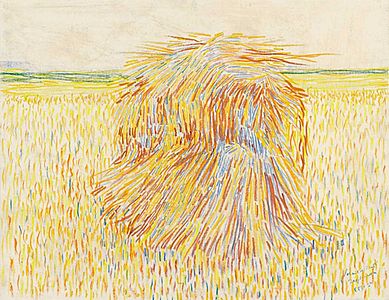Johan Thorn Prikker facts for kids
Quick facts for kids
Johan Thorn Prikker
|
|
|---|---|

Photograph c.1900
|
|
| Born | June 5, 1868 |
| Died | March 5, 1932 (aged 63) |
| Nationality | Dutch |
| Known for | Painting |
| Movement | Art Nouveau |
Johan Thorn Prikker (born June 6, 1868, in The Hague, died March 5, 1932, in Cologne) was a talented Dutch artist. He moved to Germany in 1904 and worked there for many years. Johan was very creative and worked in many different art forms. He designed buildings, made prints, furniture, and beautiful stained-glass windows. He also created mosaics, tapestries, and even book covers, besides his paintings. His art style changed over time, including Symbolism, Impressionism, and Art Nouveau.
Contents
About Johan Thorn Prikker's Life
Johan Thorn Prikker's father was a house painter. From 1881 to 1887, Johan studied at the Royal Academy of Art, The Hague. However, he left before finishing his studies.
Early Art and Influences
In 1890, his friend Jan Toorop showed him the work of a Belgian art group called Les XX. Johan even exhibited his art with them. Two years later, Joséphin Péladan introduced him to another art group, the Salon de la Rose + Croix. Much of his Symbolist paintings were created between 1891 and 1895.
Designing and Challenges
In 1898, Johan became the art director of an "Arts & Crafts" gallery in The Hague. This gallery sold many Art Nouveau items and furniture, as well as artworks. He started designing furniture around this time. His designs were inspired by Henry Van de Velde, whom he had met in Belgium.
That same year, Johan got married. Sadly, his wife passed away a year later. In 1900, he had a disagreement with the gallery's founder and left his job. The next year, he worked with Van Velde and Johan Coenraad Altorf to design a house called "Villa De Zeemeeuw" (Seagull) in Scheveningen. They wanted the house to be a complete work of art, where everything from the building to the furniture was designed together.
Despite his success, Johan's unique art style often clashed with what was popular at the time. Also, his political beliefs caused problems. He was an anarchist, meaning he believed in less government control. Most of the Dutch art world at the time preferred socialism. This made it hard for him to find work. So, in 1904, he decided to move to Germany.
Teaching and New Opportunities
In Germany, with help from art historian Friedrich Deneken, Johan got a teaching job. He taught at the new "Handwerker- und Kunstgewerbesschule" in Krefeld. This job allowed him to freely design furniture and fabrics. He also took his students on trips to paint outdoors, a style known as plein air.
In 1910, he moved to Hagen to join an exciting new art movement. Here, he received many requests to create large artworks. These included murals (wall paintings), mosaics, and stained-glass windows. Some of his famous works were for the Gesellenhaus (a meeting hall) in Neuss. During his time in Hagen, he also taught at the Kunstgewerbeschule in Essen and got married again. His son, Heinrich, later became a famous motorcycle racer. From 1917 to 1918, Johan taught Josef Albers how to make stained-glass. This greatly influenced Albers' own art.
Later Years and Focus
After a short stay in Überlingen from 1919 to 1920, Johan moved to Munich. There, he taught glass-painting and monumental art. Later, he taught at the Kunstakademie Düsseldorf and then at the Cologne Art and Craft Schools in 1926. He stayed in Cologne until he passed away. In his last ten years, he mostly focused on creating mosaics and stained-glass art.
Selected Works
Images for kids
See also
 In Spanish: Jan Thorn Prikker para niños
In Spanish: Jan Thorn Prikker para niños





